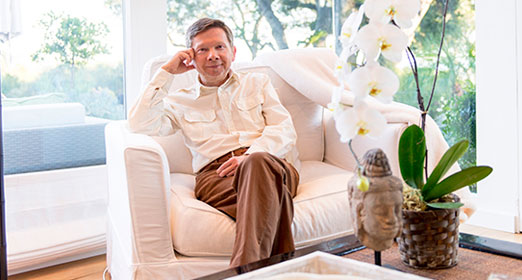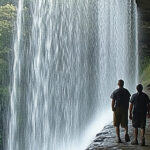by Jodi Ettenberg: I went to New Zealand to break my brain and put it back together, without ever having meditated before. I had no idea what I was in for…
signed up for a Vipassana course in a moment of quiet desperation. I was coming up on close to a year of insomnia. I found myself exhausted by the anxiety of not sleeping, yet unable to find any meaningful rest. For the first time in my life I was having panic attacks. Nightly, they were triggered by the dawning realization that sleep would elude me yet again.
I was also dealing with chronic pain. A bad accident as a kid followed by a series of rib fractures and back injuries over the years generated a state of permanent hurt made worse with the lack of sleep and an excess of cortisol.
I chose this specific course, which took place in New Zealand, because despite the trendiness of meditation classes and apps, Vipassana seemed to be about equanimity, discipline and hard work – right up my alley. I am not the most woo woo of humans, and the idea of a giant drum circle of positive thinkers made me want to run away screaming.
Vipassana is different from mindfulness meditation, which focuses on awareness, or to transcendental meditation, which uses a mantra. Instead, it dictates a blanket command of non-reaction. No matter the pain as you sit, or the fact that your hands and legs fall asleep and that your brain is crying for release. You are instructed to refocus attention on the objective sensations in your body, arising and falling, as you do a scan of your limbs in a specific order. By doing so, over 10 days, you train yourself to stop reacting to the vicissitudes of life.
While descended from Buddhism, the modern-day courses are secular in nature. The father of these retreats is the late SN Goenka, who was raised in Myanmar and learned Vipassana from monks there.
When a friend asked me why I was willingly heading into solitary confinement, especially since I had never meditated before, I told her I wanted to break my brain and put it back together again.
“I need to defrag my hard drive,” I quipped. “It isn’t running efficiently.” I compared it to hiring a personal trainer to help me at a first-ever gym session.
She disagreed.
“No, it’s like running a marathon having never run before. Jodi what are you doing to yourself?”

On the first day, a bell rang outside my door at 4am, reminding me that despite the darkness, it was time to wake up.
I was not, nor will I ever be, a morning person. I felt a rush of anger rise up in me when I heard that sound, and fantasized about taking the gong and flinging it into the forest. So much for equanimity.
I tumbled out of my cot and got ready for the 4.30am meditation session. The first day’s focus was on awareness of breath. That’s it. When your mind moved from that awareness you brought your mind back to the fact that you breathe. The simplicity of this instruction felt incredibly futile.
I had a hard time focusing on my breath because of the persistent burning in my back. Regardless of how many pillows I piled under my knees, it bubbled up until it hit a crescendo.
You are allowed to speak to the teacher during office hours, and I went that first day, knotted in pain and panic. Eyeing me serenely, he asked how long I had been meditating. Sheepishly, I explained that I hadn’t actually meditated before. Plus my back was falling apart. Plus I didn’t know how to focus on my breath. I should leave, right?
With total calm, he told me to disassociate my panic from the pain. I was making it worse for myself by focusing on the hurt, which only magnified it for me. He told me to do my best, whatever that was.
I snorted before I could help myself.
“Oh, you’re one of those,” he said with a soft smile. “Perfectionism won’t help you here.”
I trudged back out of the meditation hall and into the bright New Zealand sunlight, reeling. The teacher offered a wooden L-shaped contraption to help prop up my back during the meditation. As to whether I was meditating correctly, he was silent.
The message was clear: I was competing against my best self, not anyone else’s.
After the first three days of focusing on breathing, we were introduced to Vipassana. This involved sequences of long body scans in a specific order. Throughout, we were instructed to be aware of the sensations or pain we feel. By not allowing ourselves to react to what our bodies felt, we were training our minds to build a barrier against blind reaction.
A simplistic example of the Vipassana technique: if your leg falls asleep as you are scanning your neck for objective sensations, your mind may wander to whether you’ll ever stand up again. You don’t move your leg to compensate. Instead, you refocus on the neck and ignore the part of your brain that is begging you to give attention to the leg pain. You remind yourself that the pain is temporary, just like everything else.
In addition to the body scans, day four marked the beginning of “hours of strong determination”. They occurred three times a day, during which we were not allowed to move. Your leg hurts? Too bad. You itch like mad on your nose? Can’t scratch it. For the entire hour, you sit and you scan your body. Along the way if there are points of pain, you observe them impersonally as your scan reaches those points, knowing they are impermanent.
In response to these new requirements, a wave of people left the course. It took all of my energy not to walk out myself.
I tried to remind myself it was only 10 days. Surely I could handle 10 days of repetition and focus? I held on by a thread, until day five.
An arachnophobe walks into a Vipassana meditation course
When I was two, a family member took me to see Raiders of the Lost Ark. I had nightmares about spiders for years, waking up screaming in the middle of the night. My arachnophobia has never waned, and I am ashamed to admit that it has dictated some of my travel plans.
Before the meditation course began I worried about the long days of silence. I did not worry about spiders. This was a mistake. The course was on a bird sanctuary outside Auckland, and I arrived only to find that spiders carpeted the wooden buildings, inside and out.
When you take a Vipassana course, you agree to abide by five precepts: no killing, no stealing, no lying, no sexual misconduct and no intoxicants. No writing, no talking, no eye contact, no communicating.
At the end of day one, I noticed a daddy longlegs struggling on the carpet but heading toward the door. I reached for the course schedule, only to realize I was about to kill something with a document that says you won’t kill anything.
Instead, I took a deep breath, skirted around the creature, and opened my door. I stood there silently cheering its departure from my room.
In the meditation hall, daddy longlegs dropped from the ceiling, feeding my anxiety. Huge black spiders dotted the corner of the room where we picked up our pillows, watching over us as we shuffled into yet another meditation session.
In response, the organizers provided us with a “spider catcher”. This was a Tupperware container plus a piece of paper to slide under it for ease of transport. I did not find this helpful.

Then, on day five, I hit peak spider. Just before bed, I caught a glimpse of a bulbous black spider in my peripheral vision, dropping out of a tiny hole near the ceiling. Unlike the many spiders on the veranda, this one was huge.
I leapt out of bed in a panic. Every time I tried to reach the spider, it would crawl in the hole again and disappear. I left the light on, drifting off only to dream about spiders and wake up breathless. Finally I shut the light decisively. At 2am, I awoke to a feeling of deep alarm and turned the light back on. The spider was dropping from the ceiling, right above my head.
Gasping, I fell sideways out of the bed. The spider, as startled as I, hastily clawed its way back toward the ceiling. I watched in horror as it spent the rest of the night eating other spiders in my room. I did not sleep at all.
Studies have shown that people who are blind or deaf have heightened ability in other bodily senses. When the brain is deprived of one input source, it is capable of reorganizing itself to support and augment other senses, a phenomenon known as “cross-modal neuroplasticity”.
I felt a small, temporary version of this phenomenon at the course. I could not speak or write, but my mind was whirring away at an alarming speed. Trapped in a cognitive cycle of shame and blame, my phobia of spiders was magnified.
The next day, I swallowed my pride and broke my noble silence. I begged the female volunteer leader to let me switch rooms. At that point in the course several people had left, and I was able to move to a different cabin.
For the rest of the week, as everyone else sat on the grass enjoying the sun between sessions, I stayed in my room, too scared to leave.
It’s funny what your brain can do to you. A friend once said that in life, worrying ahead of time was futile, because what you are scared of never manifests. Instead, what you least expect creeps up behind you and scares you out of your mind. Or in my case, drops down from the ceiling in plain view.
I wish I could say that the spider incident was a turning point. It was simply a bump along the way. I did fulfill my goal of making it to the end, but the course remains one of the most difficult things I’ve ever chosen to do.
By day six, I felt exhausted by the pain, the sleepless nights, and a mind slowly unspooling. Some people talk about intruding memories of childhood or overly sexual thoughts during their Vipassana experience. For me, the challenge was suppressing the urge to run around like a toddler.
Instead of doing a body scan, I fantasized about flinging off my pillows and running through the empty space in the center of the hall, screaming like a banshee. I daydreamed of doing snow angels on the worn carpet, making a mockery of the meditation.
Day eight was the first time I sat through a “strong hour” without moving. When the gong rang, I was covered in sweat from the effort of thinking past the pain.
By the end of the course, students often report feeling full body flow of energy during meditation. I did not. I felt shelves of pain along the way, no fluidity between them. But by the last day I could scan fluidly through arms or my right leg. More importantly, I could refocus my mind away from the pain.
It was progress.
Lessons learned
I emerged from the course a calmer, temporarily less anxious version of myself. I started to sleep again. The relief of rest was palpable.
I wrote down the following takeaways once I was reunited with my pen and paper:
1. Our collective obsession with finding happiness is not a reason to meditate.
Logic and neuroscience might ground the modern rationale for meditation, but to meditate in order to be happy is counterintuitive. The practice is a counterweight to the jagged peaks and valleys of the human experience. To remain stable when life goes awry is a happier result than grasping for whatever society tells you will make you happy.
2. So much of what complicates our lives comes from assumptions we make and our reactions to them.
In the quiet of those 10 days, you see how much your mind distorts the reality you perceive. You don’t know the background of the people taking the course with you, but you create lives for them in your mind. You project your fears on to their perception of you.
For me, this meant creating inaccurate stories about the other participants, as well as their reactions to me.
I kept falling asleep during morning session, keeling over into the person next to me. I heard the snickers of the group as I righted myself again, and vowed to apologize to that woman as soon as the course was over.
When I did say sorry, the woman looked at me askance. “What? Don’t apologize – it was the only thing that made me smile during the last 10 days!”
In the strangled silence, my brain had lost perspective.
Often, anger or fears are reactions to a reality we have created in our own minds. A reflection of the stories that we tell ourselves. We take sensory input as objective, but what we see, hear and feel is not objective. It is colored by what we have known, and the grudges we hold without even realizing them.
3. You have to do the work.
Shortcuts exist in life, but to train your brain you need put in a significant amount of effort. The first few days are devastating because the work is both mindless and extremely taxing. But you can see a change in a mere 10 days, with disciplined practice.
4. Perfectionism can be dangerous.
Believing that doing your best isn’t good enough is dangerous. There is no perfect, and there is no objective measure of what “right” can be. The course reminded me that if you have a value system that thrives on making decisions with integrity, for the right reasons, doing your best is good enough.
5. Training yourself to stop reacting can help in tolerating pain.
As someone with chronic pain, this lesson was important. I would not have come to this conclusion without the course either, because I’m far too stubborn. I can see with hindsight that by obsessing over the pain, I exacerbated it tremendously.
Sometimes we hold on to what we fear and hate. While I still ache, that ache has less power over me. The distinction sounds slight but it has been liberating.
One year later
The Vipassana did not cure me of insomnia or anxiety permanently. Instead, it provided me with a valuable tool: it showed me that I could manage my mind more than I realized. By doing so, I felt more in control of the catastrophizing, despite the fact that it is always there.
A full 10 days of constant meditation created a barrier between the worrying and me. It allowed me to observe the anxiety more objectively. The whole process calmed me at a deep and inexplicable level; I am still the same neurotic person I always was, but it imbued me with a sense of perspective I now maintain and am deeply grateful for.
Would I do the course again? Definitely. A yearly 10-day silent course is recommended for those who meditate, but given the way that this one tested my body and mind, I suspect I’ll wait a little longer.
Maybe 2017 is a good year to schedule my next brain defrag.









































